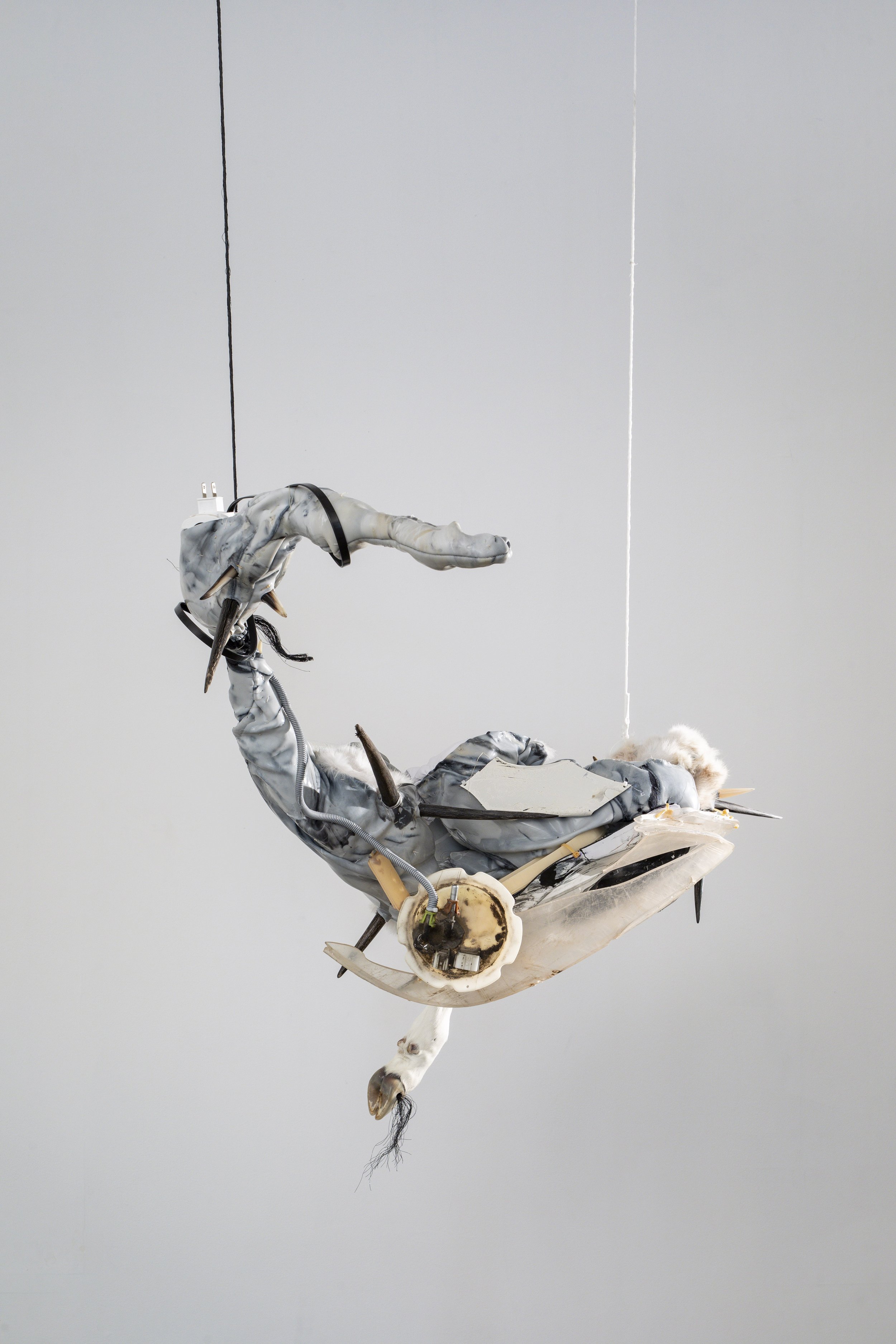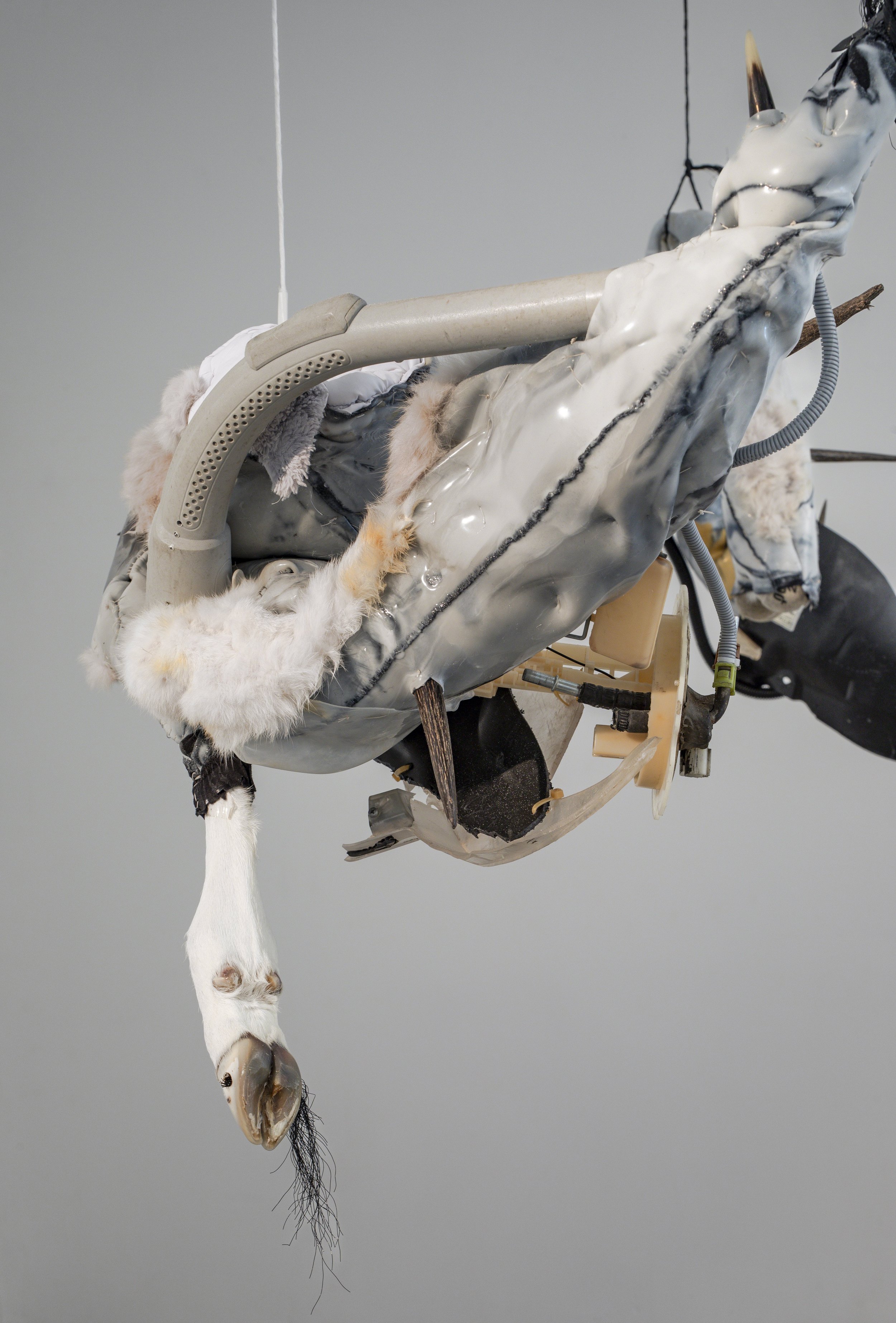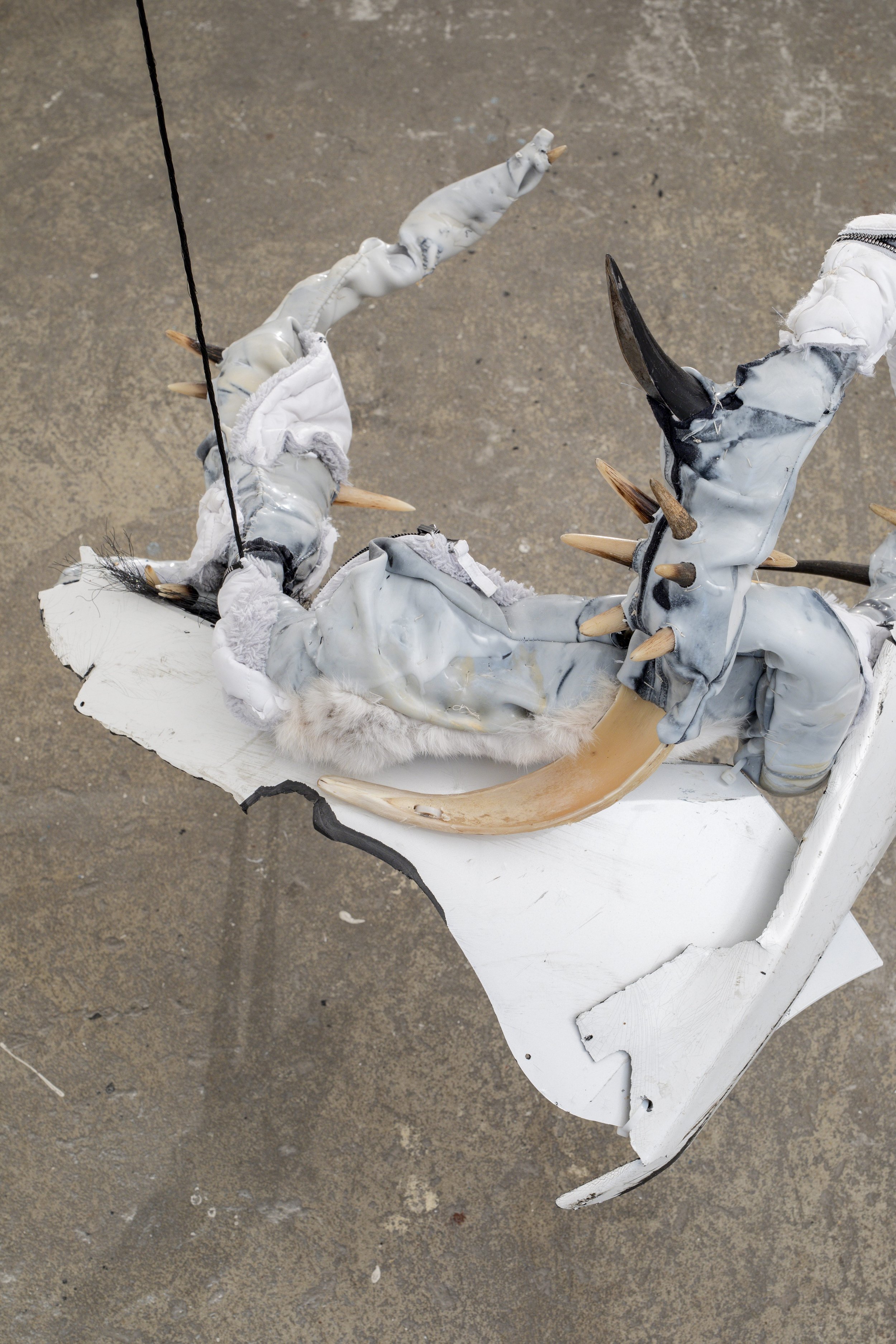Ruben Ulises Rodriguez Montoya | James Webb and the Thestral Born Without a Vertebrae
September 29 – November 5, 2022
Ruben Ulises Rodriguez Montoya | James Webb and the Thestral Born Without a Vertebrae
September 29 – November 5, 2022
Sargent’s Daughters is pleased to present the second exhibition of work by Ruben Ulises Rodriguez Montoya at the gallery, James Webb and the Thestral Born Without a Vertebrae. Composed of new sculptures and site-specific installations, the conceptual framework of this exhibition is elucidated in a narrative text written by the artist. The text, included below, depicts a vampire forced to reconstitute its body from space debris following the destruction of the last human spaceship leaving a destroyed Earth.
James Webb and the Thestral Born Without a Vertebrae
“But he was in empty space surrounded by blackness, feeding from the impossibly bright light of the sun, falling away from the great blue curve of the earth, aware over all the body of the great number of distant stars. They were gentle touches, and the sun was a great confining hand, gentle but inescapable.”
-Octavia E. Butler, Adulthood Rites: book two of the Xenogenesis Trilogy (1988)
Far away, beyond the gaze of god, inside the spaceship carrying the last survivors of the human especies, a fasting vampire suspended off the ground slowly turns clockwise in a prism-shaped chamber with padding on all sides. Its eyes are closed to better feel and hear the surroundings of space for signs of more hosts able to provide it with the blood supply it needs. As it drifts in its chamber, a long and twisting tail occasionally shows itself over billowing black robes that spread around its weightless body. With long black nails, it clicks open the doors that lead to its prey.
The ship is quiet inside except for the sounds of the machines that keep its crew in catatonic dormancy. Having smuggled into the ship, the vampire has survived total desiccation by pacing the amount of blood it takes from its defenseless human hosts. Because of its immortality and ability to cheat malaise by going to sleep for long periods of time, the vampire is perfectly suited for interminable trips in space. As it cares for its feed, it rides alone looking past the gold-layered windows of the ship. The gold deflecting and protecting it from the murderous rays of unnamed suns.
The precious materials of the spacecraft were sourced during a time when Earth's gold was no longer a natural resource. Generous amounts of the malleable substance were melted from artifacts of civilizations past. The crowns of a Spanish and English queen are now nothing more than parts of a system of conduits that transfer communication and heat deflectors that maintain a uniform temperature throughout the ship.
After an epoch of astral travel, the migration of the ship comes to a close, not by an unforeseen cosmic entity but by a foreign force inside the ship. Surreptitiously integrated into the bowels of the mainframe, a programmed virus, placed by some of the humans who were not permitted to steward humanity's new enterprise, detonates. There is no countdown, no red flash or voices directing towards evacuation. Only the sense of something gone wrong before the fiery roar of a force pushing everything out of its path.
The vampire receives the impact of the explosion as it ties itself to the open and punishing force of empty space, the extreme environment latches on to its body. Bones splinter through an already burnt and opened skin. Its fangs and jaw are yanked from its open mouth and its skin turns inside out – both blessed and cursed by its immortality. Its body isn't dead, yet it floats in curdled tentacular pieces to hide in the shadow of the remnants of the ship. Away from the direction of the nearest star.
Its corporal remains ride along the detritus of the ship, each part feeling its proximity and the loss of parts lost to the triggering pull of larger celestial bodies. Without blood to feed on, the shards of its body slowly adapt to use the fuel that powered the ship as energy. Its new host provides it with the energy needed for augmentation, growth, and healing.
In time, it coagulates more and more layers of its new body around the weaker connections with the remnants of the ship. There, the lumps of tissue find rhythm and hope again in the chaos of what's left of its body, fighting to create its own axis, circling onto itself, but holding its position while discarding parts of itself that it can't use. It lets go of the skin that is too burnt and damaged to revive, it covers scars that are still healing with scraps of an astronaut's suit. A glimpse of deep time passes before the larger parts of the vampire start to come together. The larger disembodied pieces summon the smaller fragments that are in close proximity to its own orbit and are finally able to touch and connect their tissues with one another.
Needing more protection and insulation from solar radiation, it blends with the gold still left on the ship. As it merges with it, it picks up the subtle and microscopic ripples that made up the previous shapes of its material composition. The lost vestiges of humanity's achievements echo and come to life in blazing stoic forms and shapes: graduation rings, hoop earrings, goblets, Ferrero Rocher, the Spanish galleons who hold in their histories the shadow of an Aztec nose ring looted from those royals seen as gods placed on this earth.
In this alchemical blending, the body of the vampire acquiesces to the footprint left in the luster of gold and its malleability, its memories transubstantiate into the vampire, feeding on humans one last time. It takes onto itself the memory of Nathan Chen using the crescendo of “Rocket Man” by Elton John to twirl his body up to the audience of the 2022 Winter Olympics to win gold; it is strengthened by the memory of a Virgin Mary necklace falling off a girl’s neck; it feeds on people hunched over landfills looking for tiny amounts of gold on plated circuit boards; it is now Maria Felix walking into Cartier in Paris with a baby crocodile to have it replicated into a gold necklace; and is finally fortified by astronaut José Moreno Hernández, the son of farmworkers, who took to space in 2007 with a gold layered helmet to protect him from the sun.
The vampire in its new photosynthetic nebulous form – now able to power itself by the light of all suns – becomes a mutation of both myth and reality. Emblazoned with the memory of Earth’s distant past, its new shape now pointing to the stars.
Ruben Ulises Rodriguez Montoya (b. 1989, Parral. Chihuahua, Mexico) graduated from Virginia Commonwealth University with an MFA in Sculpture + Extended Media in 2020. Montoya’s works are a fantastic becoming that center around anthologies and social issues concerning border culture, abjection, and mestizaje. Aided by magical realism, nahualismo, Sci-Fi, and the labor of his family, his work hybridizes and creates parallels between land, human, and animal as a way to investigate the process in which violence eradicates, erases, and erodes communities of color. He has recently exhibited at the Palm Springs Art Museum, Palm Springs, CA; François Ghebaly, Los Angeles, CA; Murmurs, Los Angeles, CA; Tuscon Museum of Contemporary Art, Tuscon, AZ; Commonwealth and Council, Los Angeles, CA; Virginia Museum of Contemporary Art, Virginia Beach, VA; Company Gallery, New York, NY; and Sargent’s Daughters, New York, NY. His work has been reviewed in artnet news, The New York Times, Hyperallergic and Contemporary Art Review LA. He is represented by Sargent’s Daughters.
James Webb y el Thestral Nacido Sin Vértebra
“Sin embargo, se encontraba en el espacio vacío rodeado de negrura, alimentándose de la luz imposiblemente brillante del sol, alejándose de la gran curva azul de la tierra, consciente sobre todo el cuerpo del gran número de estrellas lejanas. Eran toques suaves, y el sol era una gran mano confinadora, suave pero ineludible.”
– Octavia E. Butler, Ritos de madurez: segundo libro de la Trilogía Xenogénesis (1988)
Lejos, más allá de la mirada de dios, al interior de la nave espacial que transporta a los últimos supervivientes de la especie humana, un vampirx en ayunas, suspendidx del suelo, gira lentamente en el sentido de las agujas del reloj en una cámara con forma de prisma acolchada por todos lados. Tiene los ojos cerrados para sentir y oír mejor los alrededores del espacio en busca de señales de más huéspedes capaces de proporcionarle el suministro de sangre que necesita. Mientras flota en su cámara, una cola larga y retorcida se muestra de vez en cuando sobre las ondulantes túnicas negras que se extienden alrededor de su cuerpo ingrávido. Con sus largas uñas negras, abre las puertas que conducen a su presa.
En su interior, la nave está en silencio, salvo por los sonidos de las máquinas que mantienen a su tripulación en letargo catatónico. Tras introducirse en la misma, le vampirx ha sobrevivido a la desecación total gracias a la cantidad de sangre que toma de sus indefensos huéspedes humanos. Debido a su inmortalidad y a su capacidad de engañar al malestar durmiendo durante largos periodos de tiempo, le vampirx está perfectamente adaptadx a los viajes interminables en el espacio. Mientras se ocupa de su alimentación, viaja solitariamente mirando por las ventanas doradas de la nave. El oro desvía y protege de los rayos asesinos de soles sin nombre.
Los preciosos materiales de la nave se obtuvieron en una época en la que el oro de la Tierra ya no era un recurso natural. Se fundieron generosas cantidades de esta sustancia maleable a partir de artefactos de civilizaciones pasadas. Las coronas de una reina española e inglesa no son ahora más que partes de un sistema de conductos que transfieren información y de deflectores de calor que mantienen una temperatura uniforme en toda la nave.
Tras una época de viajes astrales, la migración de la nave llega a su fin, no por una entidad cósmica imprevista, sino por una fuerza extraña dentro de la misma. Integrado secretamente en las entrañas del ordenador central, un virus programado, colocado por algunos de los humanos a los que no se les permitió dirigir la nueva empresa de la humanidad, detona. No hay una cuenta regresiva, ni un destello rojo, ni voces que indiquen la evacuación. Sólo la sensación de que algo ha salido mal antes del rugido ardiente de una fuerza que empuja todo a su paso.
Le vampirx recibe el impacto de la explosión mientras se aferra a la fuerza abierta y castigadora del espacio vacío, el ambiente extremo se aferra a su cuerpo. Los huesos se astillan a través de una piel ya quemada y abierta. Sus colmillos y su mandíbula son arrancados de su boca abierta y su piel se vuelca hacia afuera. Bendecidx y malditx por su inmortalidad. Su cuerpo no está muerto, pero flota en trozos tentaculares cuajados para esconderse en la sombra de los restos de la nave. Lejos de la dirección de la estrella más cercana.
Sus restos corporales cabalgan por los detritos de la nave, sintiendo cada parte su proximidad y la pérdida de partes extraviadas ante el tirón desencadenante de cuerpos celestes mayores. Sin sangre de la que alimentarse, los fragmentos de su cuerpo se adaptan lentamente para utilizar como energía el combustible que alimentaba la nave. Su nuevo huésped le proporciona la energía necesaria para aumentar, crecer y curarse.
Con el tiempo, alrededor de las conexiones más débiles de los restos de la nave, coagula más y más capas de su nuevo cuerpo. Allí, los grumos de tejido vuelven a encontrar el ritmo y la esperanza en el caos de lo que queda de su cuerpo, luchando por crear su propio eje, dando vueltas sobre sí mismo, pero manteniendo su posición, mientras descarta las partes de sí mismo que no puede utilizar. Se desprende de la piel que está demasiado quemada y dañada para revivir, cubre las cicatrices que aún están sanando con retazos del traje de astronauta. Pasa un instante de tiempo profundo antes de que las partes más grandes del vampirx empiecen a reunirse. Los trozos más grandes sin cuerpo convocan a los fragmentos más pequeños que se encuentran en la proximidad de su propia órbita y que por fin son capaces de tocar y conectar sus tejidos entre sí.
Al necesitar más protección y aislamiento de la radiación solar, se mezcla con el oro que aún queda en la nave. Al fundirse con él, recoge las sutiles y microscópicas ondulaciones que conformaban las formas anteriores de su composición material. Los vestigios perdidos de los logros de la humanidad resuenan y cobran vida en formas y figuras estoicas y resplandecientes; anillos de graduación, aretes de aro, copas, Ferrero Rocher, los galeones españoles que guardan en sus historias la sombra de una argolla de nariz azteca saqueada a aquellos miembros del imperio vistos como dioses puestos en la tierra.
En esta mezcla alquímica, el cuerpo del vampirx acepta las huellas plasmada en el brillo del oro, sus recuerdos se transubstancian en le vampirx, alimentándose de los humanos por última vez. Toma sobre sí el recuerdo de Nathan Chen utilizando el crescendo de Rocket Man de Elton John para hacer girar su cuerpo ante el público de los Juegos Olímpicos de Invierno de 2022 para ganar el oro; se fortalece con el recuerdo de un collar de la Virgen María que se cae del cuello de una niña; se alimenta de gente encorvada sobre los vertederos en busca de pequeñas cantidades de oro en placas de circuitos chapados; ahora es María Félix entrando a Cartier, en París, con un cocodrilo bebé para que lo repliquen en un collar de oro; y finalmente se fortalece con el astronauta José Moreno Hernández, hijo de campesinos que salió al espacio en 2007 con un casco de capas de oro para protegerse del sol.
Le vampirx en su nueva forma nebulosa fotosintética, ahora capaz de alimentarse con la luz de todos los soles, se convierte en una mutación tanto del mito como de la realidad. Bañado por el recuerdo del pasado lejano de la Tierra, su nueva forma apunta ahora a las estrellas.
Traducción y edición de Rossen Ventzislavov, Christal Pérez, Octavio Gomez, y Diego del Valle Ríos
Rubén Ulises Rodríguez Montoya (n. 1989, Parral. Chihuahua, México) se graduó de Virginia Commonwealth University con una Maestría en Escultura + Medios Extendidos en 2020. El arte de Montoya son un devenir fantástico que se centran en antologías y temas sociales relacionados con la cultura fronteriza, la abyección, y mestizaje. Con la ayuda del realismo mágico, el nahualismo, la ciencia ficción y el trabajo de su familia, su trabajo hibridiza y crea paralelos entre la tierra, lo humano y lo animal como una forma de investigar el proceso en el que la violencia erradica, borra y erosiona las comunidades de color. Recientemente ha expuesto en el Palm Springs Art Museum, Palm Springs, CA; François Ghebaly, Los Angeles, CA; Murmurs, Los Angeles, CA; Tuscon Museum of Contemporary Art, Tuscon, AZ; Commonwealth and Council, Los Angeles, CA; Virginia Museum of Contemporary Art, Virginia Beach, VA; Company Gallery, New York, NY; y Sargent’s Daughters, New York, NY. Su arte fue revisando por el New York Times, artnet news, Hyperallergic, y Contemporary Art Review LA. Montoya está representada por Sargent’s Daughters.















